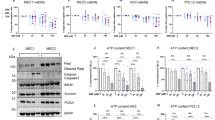Abstract
Background
A potential anti-inflammatory effect of clodronate—an aminobisphosphonate—was described to antagonize the pro-inflammatory effects of the block in the mevalonate pathway, the main feature of a rare auto-inflammatory disease called mevalonate kinase deficiency (MKD).
Objective
In this study we evaluated the potential anti-inflammatory effect of clodronate in MKD—a still orphan drug pediatric disease.
Methods
We studied some biological parameters, nitric oxide production using Griess reagents and programmed cell death by flow cytometry, as common inflammatory parameters in MKD, in the presence of different doses of clodronate (1, 10 and 100 μM).
Results
In our cellular model and in monocytes from patients with MKD, clodronate induced an increase in programed cell death and nitric oxide production in comparison with non-treated cells.
Conclusion
Our findings suggest that clodronate does not have an anti-inflammatory effect as previously reported but that it increases the epiphenomena of this pediatric disease.



Similar content being viewed by others
References
Kuijk LM, Beekman JM, Koster J, et al. HMG-CoA reductase inhibition induces IL-1beta release through Rac1/PI3 K/PKB-dependent caspase-1 activation. Blood. 2008;112:3563–73.
Mandey SH, Kuijk LM, Frenkel J, et al. A role for geranylgeranylation in interleukin-1beta secretion. Arthritis Rheum. 2006;54:3690–5.
Marcuzzi A, Pontillo A, De Leo L, et al. Natural isoprenoids are able to reduce inflammation in a mouse model of mevalonate kinase deficiency. Pediatr Res. 2008;64:177–82.
Bodar EJ, van der Hilst JC, Drenth JP, et al. Effect of etanercept and anakinra on inflammatory attacks in the hyper-IgD syndrome: introducing a vaccination provocation model. Neth J Med. 2005;63:260–4.
Marcuzzi A, Piscianz E, Girardelli M, et al. Defect in mevalonate pathway induces pyroptosis in Raw 264.7 murine monocytes. Apoptosis. 2011;16:882–8.
Marcuzzi A, Tommasini A, Crovella S, et al. Natural isoprenoids inhibit LPS induced-production of cytokines and nitric oxide in aminobisphosphonate-treated monocytes. Int Immunopharmacol. 2010;10:639–42.
Cailliez M, Garaix F, Rousset-Rouviere C, et al. Anakinra is safe and effective in controlling hyperimmunoglobulinaemia D syndrome-associated febrile crisis. J Inherit Metab Dis. 2006;29:763.
van der Hilst JC, Bodar EJ, Barron KS, et al. Long-term follow-up, clinical features and quality of life in a series of 103 patients with hyperimmunoglobulinemia D syndrome. Medicine. 2008;87:301–10.
Shikama Y, Nagai Y, Okada S, et al. Pro-IL-1beta accumulation in macrophages by alendronate and its prevention by clodronate. Toxicol Lett. 2010;199:123–8.
De Leo L, Marcuzzi A, Decorti G, et al. Targeting farnesyl-transferase as a novel therapeutic strategy for mevalonate kinase deficiency: in vitro and in vivo approaches. Pharmacol Res. 2010;61:506–10.
Makkonen N, Salminen A, Rogers MJ, et al. Contrasting effects of alendronate and clodronate on RAW 264 macrophages: the role of a bisphosphonate metabolite. Eur J Pharm Sci. 1999;8:109–18.
Frith JC, Rogers MJ. Antagonist effects of different classes of bisphosphonates in osteoclasts and macrophages in vitro. J Bone Miner Res. 2003;18:204–12.
Moreau MF, Guillet C, Massin P, et al. Comparative effects of five bisphosphonates on apoptosis of macrophage cells in vitro. Biochem Pharmacol. 2007;73:718–23.
Makkonen N, Hirvonen MR, Teravainen T, et al. Different effects of three bisphosphonates on nitric oxide production by Raw 264 macrophages-like cells in vitro. J Pharmacol Exp Ther. 1996;277:1097–102.
Russell RG. Bisphosphonates: the first 40 years. Bone. 2011;49:2–19.
Acknowledgments
S.C. is recipient of a fellowship grant from the European Project “Talents for an International House” within the 7th Research & Development Framework Programme PEOPLE–Marie Curie Actions–COFUND (Co-Funding of Regional, National and International Programmes). This work was supported by a grant from the Institute for Maternal and Child Health-IRCCS “Burlo Garofolo”, TS, Italy (RC 42/2011).
Author information
Authors and Affiliations
Corresponding author
Additional information
Responsible Editor: John Di Battista.
Rights and permissions
About this article
Cite this article
Zanin, V., Marcuzzi, A., Piscianz, E. et al. The effect of clodronate on a mevalonate kinase deficiency cellular model. Inflamm. Res. 61, 1363–1367 (2012). https://doi.org/10.1007/s00011-012-0537-4
Received:
Revised:
Accepted:
Published:
Issue Date:
DOI: https://doi.org/10.1007/s00011-012-0537-4




